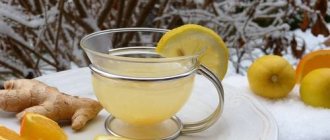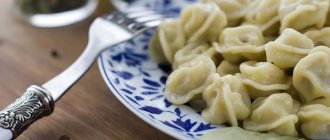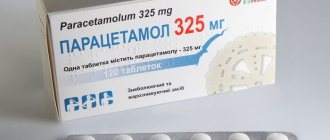Pancreatitis is a disease that occurs as a result of disruption of the pancreas, whose duct is blocked by stones, a cyst or a neoplasm. As a result, the outflow of digestive enzymes entering the intestines is disrupted. The disease occurs due to improper diet or unbalanced nutrition. Treatment and prevention of pancreatitis are necessary; the disease leads to serious disorders of the digestive system.
To treat pancreatitis and maintain normal functioning of the pancreas, a variety of medications and traditional medicine are used. In particular, various herbal infusions, infusions and teas. Ginger occupies a significant place in the list of herbal medicines.
The benefits of ginger root and its properties
Today, there is a large number of polemical discussions about whether ginger can be used for pancreatitis.
Despite the fact that there is still no clear answer to this question with reference to scientific research, most doctors are not inclined to believe that ginger is beneficial for pancreatitis of the pancreas. Ginger is a universal seasoning. It is used as a spice in the preparation of various fish and meat dishes, as an addition to soups. Can be used by adding to tea. Therefore, if you are going to dine out, be sure to inquire about the composition of the prepared food.
This prevalence of the root is due to its beneficial properties. Ginger contains a large amount of useful minerals (for example, iron, magnesium, potassium, phosphorus, etc.), as well as vitamins A, C, and some B groups.
Ginger is also used for pancreatitis because it has a direct effect on the homeostasis of the body. The root of this plant has a tonic, anti-inflammatory, and calming effect.
It also has a positive effect on the body’s lipid metabolism (therefore it is often used in the fight against excess weight), relieves the feeling of nausea, and improves well-being during colds.
Ginger normalizes the functioning of the circulatory system. Some studies also indicate its ability to fight cancer cells.
Black tea for pancreatitis
Many people wonder whether it is possible to drink black tea if the pancreas is inflamed. There is no definite answer to this question, however, most people are inclined to believe that it is possible to drink black tea, you just need to follow some rules.
First of all, the drink should not be strong. Since the alkaloids and essential oils it contains negatively affect the functioning of the pancreas. And secondly, black tea should not have any flavorings or synthetic additives, as they have a bad effect on pancreatic function. Taking into account the tonic effect of tea, the drink should be drunk in the morning and afternoon. During an exacerbation of the disease, black tea should be avoided.
Does eating ginger harm the body?
In contrast to its beneficial properties, ginger root has a number of negative characteristics that limit its use. These include, for example, the following:
- Specific taste characteristics of the root. Using large amounts of ginger can cause a burning sensation, and subsequently even lead to minor burns of the digestive tract mucosa.
- The essential oils that make up the plant have tonic and stimulating properties. This can lead to activation of the secretory functions of the stomach and glands of the digestive tract. That is why the question “is it possible to use ginger for pancreatitis?” there is still no clear answer.
- The use of this root in the chronic form of the disease can provoke its exacerbation and a general deterioration in the patient’s well-being.
- When consuming the root during a period of stable remission, the likelihood of relapse of the disease increases.
Pancreatitis and ginger, despite the large number of arguments for the benefits of such a symbiosis, are often incompatible. Official medicine does not recommend using this seasoning in large quantities or for a long time and systematically.
However, each patient makes the final decision on whether it is possible to eat ginger for pancreatitis independently in accordance with his beliefs on this matter. In this case, you should first consult with a gastroenterologist.
It is also worth talking about how ginger for pancreatitis and cholecystitis generally affects the gastrointestinal tract of the human body. The effect of such spices on the digestive system is very ambiguous. The use of ginger in large quantities can cause local burns of the mucous membrane of the digestive system, as already noted.
If this occurs in the presence of a chronic pathological process (or even in a state of remission), swelling of the gland is possible, which is accompanied by painful attacks. The pain is girdling in nature and often radiates.
This is another reason why ginger is not entirely suitable for pancreatitis.
Harm of ginger
Ginger is a hot spice; if used incorrectly or uncontrolled, it is easy to irritate or burn the gastric mucosa.
Ginger contains many essential oils and gingerol, which activate the production of gastric secretions. Therefore, official medicine categorically does not recommend ginger for pancreatitis! Other spices and seasonings that have irritating and stimulating properties are excluded from the diet of patients suffering from acute and chronic forms of pancreatitis.
Using ginger even in small quantities, regardless of the method of preparation: fresh, pickled or dried, can cause a severe attack with acute pain. The situation should be taken very seriously; as a result, necrosis of pancreatic tissue and nearby organs is provoked. If, during the treatment of pancreatitis, a stable remission has occurred and attacks have not occurred for a long time, you should not use ginger.
All kinds of recipes promising treatment of the gastrointestinal tract based on the use of ginger have their origins in oriental medicine. Ancient science prescribes tiny doses of the product - exclusively in the form of medicine. Eating ginger for pancreatitis is strictly contraindicated.
Ginger tea causes less irritation of the mucous membranes, and this drink can be consumed if you have pancreatitis.
Making ginger tea for disease prevention
It is worth noting that ginger is used for prophylactic purposes to prevent pathologies of the development of the gastrointestinal tract in the future. The process of drying the root itself is of great importance here. To do this, you need to cut it into small circles and then soak in warm water for several minutes.
Next, remove it, dry it from water, and place it in a place exposed to direct sunlight. This drying occurs over several months.
After this, you can prepare tea with the addition of ginger. To do this, 20 grams of root must be poured into 300 ml. boiled water and let it cool, and drink the product not strong and with a drop of honey. However, its use is not recommended on an empty stomach, or if there are pathologies of the pancreas.
Advice on using ginger for general cleansing of the body is based on the experience of the therapeutic tactics of Eastern medicine. However, there the use of the root of this plant occurs extremely carefully, in minimal doses, and only for medicinal purposes. Its use as a seasoning to improve taste, as well as for preventive purposes, is not practiced.
So, this article describes the effect that ginger has on the human body during pancreatitis. Whether it can be used, and whether it is advisable to do so, each patient decides for himself. In this case, it is recommended to consult a doctor, who will give some advice on this issue.
- Using the monastery collection to treat pancreatitis
You will be surprised how quickly the disease recedes. Take care of your pancreas! Over 10,000 people have noticed significant improvements in their health simply by drinking a morning drink...
The healing properties of hawthorn for pancreatitis
Hawthorn for pancreatitis and cholecystitis is taken as part of a medicinal herbal collection precisely as a means of relieving inflammation. Immortelle leaves, tansy and other choleretic herbs are added to the hawthorn decoction.
Recipes with chamomile against inflammation of the pancreas
Chamomile has proven itself to be the best, since after taking it throughout the course of treatment, patients feel relief and restoration of the body’s strength after acute attacks of the disease
How and why should you take flaxseed oil for pancreatitis?
Flax is widely used in the treatment of a different range of diseases, including diseases of the stomach and pancreas. For a positive effect, doctors do not recommend eating more than a tablespoon of the product during the day.
Treatment of pancreatitis with milk thistle at home
Thanks to its rich composition, which also includes biological substances, milk thistle is the first drug that should be used as therapy for pancreatitis
For diseases of the digestive system, doctors recommend following a strict diet that excludes the consumption of all hot, spicy, salty and other harmful foods. Ginger for pancreatitis, despite the large number of useful substances, is prohibited from being consumed, as it can provoke an exacerbation of inflammation and the development of dangerous complications.
Contraindications for use in diseases of the pancreas
Ginger root can be consumed both dry and fresh, but it is the latter option that is best suited for preparing drinks, first and second courses. For inflammation of the pancreas, the current method of treatment would be tea from the plant and compresses based on a decoction from it; True, even in this case it is worth taking into account the stage of development of the disease and your own well-being.
Did you know? Any ginger-based drink is a wonderful sedative that perfectly reduces anxiety levels and improves mood.
Ginger tea
Ginger tea for pancreatitis is the most gentle option for using the plant, however, in the acute period, even it can cause complications of the condition. In case of persistent remission of the disease, the drink helps reduce inflammation, relieve swelling from soft tissues and improve metabolic processes, and to increase the taste properties of the composition, you can add a few drops of lemon juice and a little honey to it.
You can prepare ginger tea during the period of remission of pancreatitis (characterized by the absence of pain) using the following recipe:
- Pour in 1 tsp. fresh (grated) or dried plant root with a glass of boiling water, place the mixture on the fire and, tightly closing the container with a lid, simmer over low heat for 10 minutes.
- To complete the process, remove the saucepan from the heat and leave at room temperature for another 25 minutes until the tea cools completely.
Important! Ready-made drinks should only be taken warm, since any hot drinks are prohibited for pancreatitis (all of them increase the secretion of digestive juices, which is unacceptable in this case).
It is better to drink ginger tea in small portions, 50-100 ml at a time, about 2-3 times a day, but if such use causes nausea, pain or any other disturbances in the usual state of health, it is better to discontinue the use of the drink.
This treatment option for pancreatitis is more gentle than the previous one, so it can be used in cases where the internal use of ginger is accompanied by unwanted side effects.
Prepare a compress according to the following action plan:
- Pour into a saucepan and boil two liters of water over low heat.
- Peel 200 g of ginger root and grate the pulp on a fine grater.
- Transfer the resulting slurry to a gauze bag and, placing it in boiling water, leave to cook for half an hour.
- After the specified time, the ginger can be taken out, and the remaining broth can be used to wet towels, which are applied to the sore spot (above the pancreas) in the form of compresses.
Keep the wet bandage on the skin for 10 minutes, then take a short break for the same time and repeat the procedure again.
A compress with pepper is a good alternative to the previous one, but it is better to do it at night. The preparation method is somewhat more complicated and requires the presence of more ingredients.
Important! Do not apply the ginger-pepper compress directly to bare skin. Red pepper is very hot and with prolonged contact can cause not only redness of the skin, but also a real burn.
The sequence of all actions in this case will be as follows:
- Take a small clay pot (or a mortar made of other material) and mix in it 2 teaspoons of chopped ginger, 0.5 teaspoon of hot red pepper and 1 teaspoon of turmeric.
- Crush all the ingredients with a pestle, trying to extract as much of the essential oils as possible.
- Dilute the resulting mixture with mustard or sesame oil to a thick sour cream, and then apply the composition to a thick cotton cloth and apply to the sore spot, placing a thin cloth napkin on it in advance.
- It is advisable to additionally secure the entire compress with bandages so that it does not move or fall off. After a few hours, the bandage and ointment can be removed.
We suggest that you familiarize yourself with Nutrition for glomerulonephritis with nephrotic syndrome - diet for glamironephritis
The issue of using spices should be decided individually for each person. Many note that thanks to regular addition of the product to food, they got rid of pain, reduced inflammation and cleared the stomach. However, such an effect may not be achieved in all cases. Before taking the root, you should consider the following contraindications:
- Acute pancreatitis, pain syndrome, general lethargy of the body.
- Chronic disease, period of exacerbation.
- Vomiting or nausea, dizziness.
- Stomach pain: attacks or constant.
- The cessation of pain symptoms a few days ago, when the disease has not yet completely receded.
If you use the spice without permission, you can only make the situation worse. Swelling, necrosis, and pain attacks may develop. Therefore, for pancreatitis, it is not recommended to use the spice even as a seasoning.
Ginger tea
Doctors categorically prohibit the use of this product when ill, even as a seasoning.
Many, knowing about the beneficial properties of the root, begin to use it to treat inflammation of the pancreas. But, despite the beneficial qualities of this product, it is extremely undesirable for people suffering from a disease such as pancreatitis. The thing is that such a medicine acts irritatingly on the mucous membranes of the digestive tract, as a result of which the activity of pancreatic secretion increases.
Some sufferers of this disease say that they were able to overcome the pain only with the help of ginger root and regular consumption of it. Yes, indeed, with its help you can cleanse the stomach and intestines, you can strengthen the body, some even believe that a diet for pancreatitis must include regular consumption of the root of this herb.
Some who have tried ginger treatment for pancreatitis may claim that such therapy helped them, but not everyone is so lucky. Each body is individual and reacts to a particular product differently, so it is impossible to say that ginger will help with treatment for everyone. On the contrary, there is a great risk of further aggravating the situation, because consuming ginger (in any form) can cause acute painful attacks and even lead to necrosis and swelling of the pancreas.
Therefore, you should not listen to the opinions of other people, rely only on the recommendations of your doctor. There is no need to aggravate an already complex and unpleasant disease. Ginger for pancreatitis is not the most important panacea.
It is worth remembering the importance of consulting with your doctor; he will help you create the right diet, which will reduce pain.
The effect of ginger on the body
For a person who does not have digestive problems, consuming ginger brings many benefits.
The root of this plant is used as food for preparing first and second courses, sauces, drinks, and confectionery.
Ginger root enriches dishes with a large number of healthy ingredients:
- vitamins C, PP, A, most representatives of group B;
- trace elements: potassium, copper, iron, magnesium, zinc, calcium, selenium;
- proteins, complex carbohydrates (coarse plant fiber);
- nicotinic, oleic and other acids;
- essential oils.
Beneficial features
Thanks to its composition, ginger has a beneficial effect on many systems and organs:
- Has an antiseptic, anthelmintic effect.
- Increases appetite.
- Eliminates spasms of smooth muscle organs.
- Increases the rate of tissue regeneration.
- Reduces nausea, judging by patient reviews.
- Strengthens the secretion of gastric juice. This effect helps improve a person’s condition with hypoacid gastritis. To treat this disease, a course of ginger tincture is recommended.
- Normalizes immunity, increases the body's resistance to various infections.
- Thins the blood, prevents the formation of blood clots, improves blood circulation.
- Normalizes the functioning of the nervous system in asthenic and depressive conditions: tones, improves mood, eliminates sleep disorders.
- Promotes burning of adipose tissue and weight loss.
- Rejuvenates, removes toxins from the body, has an antioxidant effect.
- Prevents the development of cancer.
Harm of ginger
Essential oils and various acids irritate the mucous membranes of the digestive tract, causing an increase in the secretion of gastric juice, bile, and pancreatic enzymes. This effect negatively affects the course of chronic pancreatitis: ginger causes an exacerbation of the disease. Clinically, this is manifested by abdominal pain, heartburn, nausea, vomiting, and diarrhea.
With the development of severe inflammation, tissue swelling and disruption of the outflow of pancreatic juice during an exacerbation of pancreatitis, pancreatic necrosis may develop due to the destruction of the organ by its own enzymes.
Ginger is harmful to the pancreas and liver, but it can also provoke exacerbation of other chronic diseases of the digestive tract (hyperacid gastritis, erosive and ulcerative lesions of the gastrointestinal tract, diseases of the small intestine, cholecystitis, gallbladder dyskinesia).
Ginger tea for inflammation of the pancreas
Even if a stable long-term remission of the inflammatory process in the pancreas is achieved, you should not eat dishes with ginger. But it is allowed to drink tea from the root of this plant. In order to prepare it, you need to grate the ginger root on a coarse grater and dry it for long-term storage. The recipe for making the drink is quite simple:
- pour a teaspoon of fresh or dried ginger root into 1 cup of hot water;
- Close the container tightly with a lid and cook over very low heat for about 10 minutes;
- Turn off the stove and leave to brew for another quarter of an hour.
Ginger tea is drunk warm: hot drinks and dishes are prohibited for pancreatitis, because they increase the secretion of digestive juices. If desired, you can add a little honey.
Take this drink in small portions: 50–100 ml, and after that you should carefully monitor your well-being. If pain, nausea and other signs of exacerbation of pancreatitis appear, ginger is excluded from the menu, even in the form of tea.
Effect on the digestive system
To treat and prevent gastrointestinal diseases, it is enough to take tea from the root every day, because ginger contains many useful vitamins and microelements. To do this, you need to cut the product into thin slices, dry it and grind it. You just need to dry it correctly, too: first, the cut slices need to be soaked in warm water, then dried for several months under the influence of sunlight, and only then crushed and eaten.
To prepare tea, pour boiling water over 30 grams of crushed root. This tea will help relieve inflammation, get rid of spasms and pain; a pleasant bonus will be the normalization of intestinal function and getting rid of fat deposits.
What else do you need to know about ginger?
In addition to pancreatitis, doctors prohibit the use of ginger root for many other pathological conditions:
- malignant neoplasms of any location;
- tendency to allergies;
- many dermatological diseases;
- bleeding (nasal, hemorrhoidal, uterine, gastrointestinal);
- blood diseases accompanied by increased bleeding;
- second half of pregnancy, breastfeeding period;
- liver diseases (cirrhosis, hepatitis);
- high body temperature in any pathological condition.
Despite the numerous healing properties of ginger and its beneficial effect on the digestive system, gastroenterologists do not recommend using it for diseases of the pancreas. Due to a pronounced increase in the secretory activity of this organ, after taking dishes from the root of a medicinal plant, exacerbation of pancreatitis and even life-threatening conditions may develop. The only approved way to consume ginger during the treatment of pancreatitis is ginger tea.
Ginger is a well-known spice used for culinary and medicinal purposes. The root is a common food because it has a strong, pungent flavor and is rich in a number of beneficial substances.
The plant has a strong healing effect on the human body. The spice stimulates the immune system, improves metabolic processes, relieves pain and cramps, eliminates nausea and helps fight colds.
But since the spice has a pungent taste, in many cases its use may be contraindicated. Therefore, the question arises: is it possible or not to use ginger for pancreatitis?
Rules for drinking tea for pancreatitis
The basic rules for drinking tea are:
- to prepare tea, regardless of the variety, use only a high-quality product;
- try not to drink bagged, granulated and powdered tea;
- Always consume only freshly prepared drinks;
- tea should not be of strong concentration;
- you should not drink too sweet or sour drinks, especially during an exacerbation;
- It is best to drink the drink after eating;
- It is advisable to drink tea in the morning and during the day; it is better to avoid it in the evening;
- in order not to overload the pancreas, it is not recommended to put milk and sugar in the drink;
- you can add a little lemon.
In order not to harm your health, it is best to consult a doctor and find out which tea is right for you.
Attention! Articles on our website are for informational purposes only. Do not resort to self-medication, it is dangerous, especially for pancreatic diseases. Be sure to consult your doctor! You can make an online appointment with a doctor through our website or select a doctor in the catalog.
PankreatitPro.ru
Composition and beneficial properties of ginger
100 g of hot plant contains 58 g of carbohydrates, 9 g of proteins and almost 6 g of fat. The calorie content of the product is quite high - 347 kcal per 100 grams.
Ginger root is rich in various microelements - sodium, potassium, zinc, manganese, selenium, copper, calcium, magnesium, iron and phosphorus. It also contains many vitamins - PP, C, E, B, A.
Ginger also contains various acids, including oleic, caprylic and nicotinic. Due to its rich composition, the root has a tonic, anti-inflammatory, antiseptic, analgesic, immunostimulating, regenerating, and anticancer effect.
Hot spice has a number of other beneficial properties:
- removes waste, toxins and other harmful substances from the body;
- improves food absorption;
- increases appetite;
- promotes weight loss;
- activates metabolism;
- eliminates indigestion, nausea and belching;
- stimulates blood circulation;
- improves the functioning of the endocrine glands and digestive system.
Using ginger for pancreatitis
It has been proven that the beneficial burning root relieves inflammatory processes in the body. Therefore, many people think that it should be used for pancreatitis. But its therapeutic effect will be noticeable only if the spice is consumed in small doses.
At the same time, ginger is known for improving the functioning of the digestive system. If you add a pinch of spice to your food, you can get rid of belching and indigestion, improve appetite and normalize the production of gastric juice.
In the east, ginger is actively used for pancreatitis of the pancreas. However, traditional medicine does not recommend using the root in acute forms of the disease. And if you use ginger during prolonged remission, it can cause an exacerbation.
Sometimes, with chronic pancreatitis, the doctor allows the patient to eat the hot root, adding it as a spice to dishes. However, the spice can only be used occasionally and in small quantities.
Tea for pancreatitis
Even in ancient times, tea was used not only to quench thirst, but also as a medicine. It was considered a precious overseas drink and every teacup was treasured. A modern assortment of all kinds of teas with funny and sophisticated names can satisfy the most capricious and picky customers. The shelves are lined with boxes and bags of black, white, yellow, red, and green tea. There are flavored and granular types. But which of them are allowed for patients with pancreatitis?
Tea and acute pancreatitis
Diet therapy for acute pancreatitis often begins with hunger. But during this difficult period, whose duration ranges from 1 to 20 days, most patients are allowed to drink. One of the acceptable drinks is tea, which:
- supplies the fluid necessary for the body;
- has a slight antidiarrheal effect (due to the tannins contained, of which tannin is the most famous);
- contains antioxidants (polyphenols) that reduce inflammation;
- has a diuretic effect, due to which it somewhat reduces the swelling of the inflamed gland.
But this tea should be:
- weak, as it contains alkaloids (theine, etc.) and essential oils, which even in small quantities have a strong effect on the body, increasing the formation and secretion of proteolytic enzymes that digest the gland itself;
- without sugar, so as not to “overwork” the pancreas with excess glucose;
- unflavored (natural and/or synthetic flavors can negatively affect pancreatic secretion and have an allergenic effect).
Considering the slight tonic effect of tea (due to the substances caffeine and theobromine), it is better to drink it (or most of it) in the first half of the day.
Tea and chronic pancreatitis
If the patient has developed an exacerbation of chronic pancreatitis, then the principles of drinking tea are the same. During remission of this disease, patients are allowed to drink fortified teas.
In addition to the already mentioned healing qualities of tea:
- reduces cravings for strong drinks (this is especially true for patients with pancreatitis of alcohol origin);
- reduces blood sugar (the effect is important for patients with pancreatitis with impaired carbohydrate metabolism);
- reduces high cholesterol;
- maintains the elasticity of blood vessels;
- may inhibit the growth of malignant cells.
To realize the beneficial effects, you should only drink freshly brewed tea (it is considered as such within an hour after preparation) and avoid granulated and powdered teas (they contain few active substances).
Chemical composition of tea (per 100 g):
- proteins – 20 g;
- fats – 5.1 g;
- energy value – 140.9 kcal.
These figures are average. The nutritional value parameters of different types and varieties of tea may differ from the figures given.
The following vitamins are found in tea: .
Summary
Maximum daily portion for chronic pancreatitis:
- acute phase – up to 5 glasses;
- phase of stable remission - up to 5 glasses.
In acute pancreatitis - up to 1.5 - 2 liters.
pancreatitu.net
Harm of ginger for inflammation of the pancreas
Assessment of the compliance of ginger with a diet for pancreatitis: - 10. Therefore, the use of the root for pancreatic diseases and cholecystitis is extremely undesirable.
The product irritates the gastrointestinal tract, stimulating their work. This only worsens the patient’s condition and leads to another attack, swelling of the pancreas or necrosis of the organ.
Other undesirable consequences of consuming hot seasoning are the occurrence of acute pain in the stomach and the area where the gland is located. Also, the root can provoke an exacerbation of chronic diseases of the stomach, liver, intestines, and pancreas.
Doctors are convinced that in case of any inflammatory processes occurring in the digestive system, consuming ginger in large quantities will lead to an exacerbation. Treatment with the root will not bring the desired effect, but it can sometimes be used as a seasoning.
In addition to pancreatitis, ginger should not be taken if you have gallbladder diseases. Although there is an opinion that for such diseases, using burning powder will help relieve pain. However, doctors recommend the use of pharmaceutical antispasmodics, the dosage of which has already been correctly calculated.
The only disease of the digestive system for which consumption of the ginger plant will be beneficial is gastritis with low acidity. For other disorders in the gastrointestinal tract, the root will only aggravate the course of the disease and have an irritating effect on the mucous membranes.
There are a number of other diseases for which the use of ginger is not recommended:
- hepatitis;
- diabetes;
- cirrhosis of the liver;
- allergy;
- diseases of the gastrointestinal tract, especially ulcers;
- elevated temperature;
- dermatoses;
- haemorrhoids;
- bleeding;
- pregnancy (last months) and lactation.
Contraindications to the use of ginger root in food for pancreatitis
Despite its high popularity, the root cannot be used as food for every person.
This product has a large number of contraindications. The main contraindications to using ginger as a seasoning in food are the following:
- the person has hemorrhoids or bleeding;
- the presence of gastrointestinal ailments in acute stages, pancreatitis;
- ulcerative colitis;
- breastfeeding period;
- increased body temperature;
- detection of liver cirrhosis;
- allergic reactions.
Using ginger seasoning in food can cause a number of negative consequences for pancreatitis and cholecystitis.
Recipes with ginger
They like to use this popular spice in both professional and home kitchens. The root is added to a variety of meat and vegetable dishes, sauces, savory baked goods and desserts (puddings, jam, mousses, cookies). Drinks such as jelly, compote, decoction and various medicines, such as tinctures, are also prepared using ginger.
But ginger tea is considered the most beneficial. The drink relieves inflammation, tones and soothes. For pancreatitis, it eliminates irritation of the pancreatic mucosa, but only if you do not overuse the decoction and drink it during the period of remission, provided there are no painful symptoms.
Ginger tea will be most beneficial if taken immediately after brewing with the addition of honey and lemon. There are many recipes for decoctions based on the burning plant. The classic way to prepare the drink is as follows:
- 0.5 teaspoon of ginger is poured with boiling water (100 ml).
- Cover the container with a lid and place on low heat for 10 minutes.
- Afterwards, remove the dishes with tea from the stove and leave for 15 minutes.
The decoction should be consumed warm with the addition of citrus fruits and honey, provided that these products are well tolerated by the body. To prepare tea, you can use fresh (crushed) or dried (ground) root. For pancreatitis, you need to take the drink extremely carefully, no more than 50-100 ml at a time.
Ginger is often used for heartburn. Its therapeutic effect is due to the fact that it improves digestion by absorbing stomach acid and calming the nervous system.
To prepare a medicine that will not only eliminate heartburn, but also improve appetite, eliminate nausea and vomiting, pour two small spoons of ginger powder into 300 ml of boiling water. The drink is infused for 2 hours and filtered. It is taken three times a day before meals in the amount of 50 ml at a time.
There is another way to prepare a decoction of ginger for dyspeptic disorders. To do this, add 200 ml of hot water to 2 parts ginger and 1 part cinnamon powder.
The product is infused for 5 minutes. It is advisable to drink the decoction in the morning.
It should be remembered that fresh ginger and the pancreas are incompatible concepts, since the plant stimulates the secretion of gastric juice, stimulates excess production of pancreatic juice and irritates the pancreatic mucosa. And this can worsen the patient’s condition - cause exacerbation and increase the intensity of symptoms.
The benefits and harms of ginger are described in the video in this article.
Ginger root is a very useful plant that is used to treat many diseases. After all, it has a lot of valuable substances. Therefore, many patients are interested in the question, is it possible to take ginger for pancreatitis? You should not rush to use this product, since it is not so harmless for patients.
How to make tea
When answering the question whether ginger can be used for pancreatitis, consider the methods of preparation and use for medicinal purposes. It cannot be included in its pure form or as a spicy addition to dishes. The pancreas and mucous membranes are damaged.
By preparing a delicious tea from it, it alleviates the patient’s condition due to its beneficial properties. Perfectly tones, soothes, suppresses pain. Allowed for use for pancreatitis, but in moderation. Drink this drink only in case of a chronic form of the disease. Do not use during exacerbation of pancreatitis.
Method of preparing tea:
- 0.5 tsp. crushed ginger root is poured with water;
- put on low heat, bring to a boil, simmer for 15 minutes;
- remove from heat, cover with a lid, leave, wrapped in a warm blanket;
- filter the infusion;
- Before use, add natural bee honey and a slice of lemon.
Drinking ginger tea for pancreatitis should be done in doses, with caution, only during the chronic course of the disease. Do not use during exacerbation. Before starting use, consult your doctor. Self-medication is dangerous and leads to negative consequences.
opodjeludochnoy.ru
Beneficial features
Ginger is a plant that is actively used in cooking and folk medicine. This product can perfectly decorate almost any dish. It is added as a seasoning almost everywhere, be it meat or sweet pastries.
Ginger brings many benefits to the body because it contains a large number of valuable elements, namely:
- various groups of vitamins;
- minerals, for example, iron, magnesium, potassium, phosphorus and others;
- various acids, in particular nicotinic, caprylic, oleic.
Thanks to the presence of sugar and starch in the plant, the human body is provided with energy. Components such as zingerone, shoagol and gingerol make its taste unique, which is why many people love it.
Scientists have conducted many studies and it has been proven that ginger is able to fight tumors, inflammation, destroy pathogenic bacteria, and strengthen the immune system.
Tea prepared from this plant is also considered very useful. It has the following beneficial effects on the body:
- normalizes blood circulation;
- stabilizes fat metabolism;
- eliminates the feeling of nausea;
- copes well with colds;
- relieves pain that occurs in muscle tissue, joints, and head.
Is it allowed to use the product for pancreatitis?
Most people are simply sure that ginger is simply necessary for pancreatitis, because it is perfectly capable of eliminating inflammatory processes in the body. And this disease is inflammation of the pancreas. However, one should not rush to such a conclusion.
Ginger can be harmful even for a healthy person. If you eat this product in moderation, it will promote easy functioning of the digestive system. If you consume more than the norm, you can expect problems with the gastrointestinal tract.
Therefore, people suffering from pathologies of the digestive system are better off forgetting about the existence of this plant. Under no circumstances should you try to cure pancreatitis with ginger tea, thinking that it will help quickly eliminate inflammation. One has only to overdo the dosage a little, and irritation of the pancreas will immediately arise and an exacerbation will begin.
This is due to the fact that the plant can irritate the digestive organs, activating their activity. As a result, the affected pancreas produces a negative reaction to such a change.
The sudden work of the digestive organs can cause pain, swelling and even necrosis. In order to avoid this, ginger for pancreatitis is prohibited by doctors. Moreover, this applies not only to the acute, but also to the chronic form.
Even if the pancreas did not react in any way to eating ginger, you should not eat it in large quantities. After all, remission can easily give way to exacerbation.
If pancreatitis occurs in a chronic form, and the patient simply cannot live without this product, then the doctor may allow it to be added as a seasoning to dishes, but in very small doses and not every day. In acute pancreatitis, even such a luxury is not permissible.
Contraindications for use in diseases of the pancreas
Any disturbances in the activity of the pancreas deserve increased attention, with timely and adequate treatment. Of course, in this case, self-medication is out of the question, so if you have some diseases, you should hold off on using ginger root.
- First of all, we are talking about such disorders:
- inflammation of the walls of the organ at the acute stage (acute pancreatitis);
- the appearance of severe pain in the pancreas and gall bladder;
- the appearance of any discomfort in the stomach;
- peptic ulcer of any type;
- heartburn;
- internal bleeding in the specified organ.
In addition, it is possible that ginger root may have a negative effect on the stomach - with gastritis (with high acidity), diverticulitis, colitis, and acute cholecystitis.
As in many other cases, the possibility of using ginger root for cholecystitis depends on the stage of the disease: chronic or acute. Of course, in the latter case, the burning plant will negatively affect the inflamed organ, which can cause it to hurt more.
We suggest you read: If you rub baking soda into problem areas
The chronic form is often characterized by a long period of remission, during which no negative manifestations in the functioning of the gallbladder are observed, which means that moderate consumption of ginger root tea will not cause any negative consequences.
When consuming even a minimal amount of ginger, it will activate secretory processes in the stomach, pancreas, and gall bladder, which, in the presence of any diseases (in particular cholecystitis), contributes to the appearance of very unpleasant pain or heartburn. At the remission stage, the plant can be used, but only in extremely small doses and after appropriate heat treatment.
Did you know? Ginger root is great for eliminating bad breath, and to freshen your breath all day long, just chew a small piece of this product immediately after eating.
Short-term treatment with high temperatures helps reduce the pungency of ginger root, so if drinks from a fresh plant are contraindicated for you, you can add it to baked goods or combine it with any warming drinks. You should not use ginger on a regular basis, but with stable remission it can be used no more than once a week.
The following can be considered popular recipes for preparing medicinal drinks:
- Option 1. Prepare a mixture of lemon balm, centaury, wormwood, barberry bark and nut leaves (10 g of each spice), and then pour a glass of boiling ginger water over the mixed ingredients. The finished infusion is drunk 3 glasses a day, between main meals.
- Option 2. Mix dried celandine, walnut leaves and chicory root in equal proportions (20 g each), then pour 1 full tablespoon of the mixture with a glass of boiled ginger water. After infusing the mixture for half an hour, all that remains is to strain it and drink 1 glass twice a day: morning and evening.
Using pickled ginger root to treat cholecystitis is one of the worst decisions, however, like any other way of consuming the plant in its pure form.
Useful in most cases, ginger can become very harmful in case of liver diseases, especially when it comes to chronic hepatitis and cirrhosis. Since any of these ailments is characterized by increased irritability of organ cells, increased secretory activity can aggravate their condition, complicating the overall situation.
This result is also possible in the presence of stones in the area of the biliary tract, which, if moved from place, can block the excretory ducts and cause intoxication of the body, not to mention increasing the likelihood of surgical removal of the stones.
Simply put, the benefits of ginger root can be revealed only if it is used correctly and there are no direct contraindications; in other situations, you should not risk your health. At a minimum, you should consult with your doctor about the appropriateness of its use for problems with the liver or pancreas.
Was this article helpful?
Thank you for your opinion!
Write in the comments what questions you have not received an answer to, we will definitely respond!
You can recommend this article to your friends!
You can recommend this article to your friends!
Yes
No
Everyone who suffers from intestinal and stomach diseases, including pancreatitis, is looking for ways not only to treat them with medication, but also use many folk remedies. In this case, ginger will come to the rescue. Although there is a lot of controversy about whether it can be used for stomach diseases, because this root itself is pungent and spicy. But if there are no chronic diseases or ulcers, then eating ginger is beneficial.
It is better, of course, to consult a doctor to avoid undesirable consequences of self-medication. An adult can use both dried and fresh plants for food. By consuming fresh ginger, a person receives more beneficial substances than by consuming dried ginger.
A possible option for using ginger for inflammation of the pancreas is ginger tea, which, having an anti-inflammatory and calming effect, removes inflammation from the mucous membrane of the affected organ.
It is recommended to drink ginger tea freshly brewed, or with the addition of lemon and honey.
The drink is approved for use in case of pancreatitis during the subside phase of the main pain symptoms with extreme caution and in small quantities.
The undeniable advantages of ginger in terms of its effect on the body of a healthy person and its effectiveness in many ailments do not in any way reduce its negative impact on the affected pancreas.
In this regard, experiments on the treatment of pancreatitis with ginger root are absolutely unacceptable - the risk in this case is unjustified and far exceeds the likely benefit.
What about cholecystitis?
What if the patient suffers from cholecystitis? Then can I use ginger root? No, in this case the same rule applies as with pancreatitis. Ginger for cholecystitis is not allowed to be used in large quantities in any form; in a small dose it can be used for the chronic course of the inflammatory process.
Some people believe that if the plant is consumed by patients with gastritis and cholecystitis, it will have an antispasmodic effect. However, this is not entirely true, so it is best to trust medical remedies. After all, not every person can choose such a dosage to eliminate the disease, and not aggravate it.
Thus, ginger has many healing properties, but its incorrect dosage can harm even a healthy body. Therefore, it is best for patients suffering from pancreatitis to avoid this product in order to avoid the development of an exacerbation of the disease. This applies not only to the pathology of the pancreas, but to the occurrence of inflammatory processes in any organ of the digestive system.











